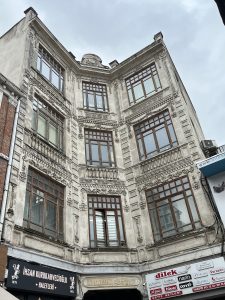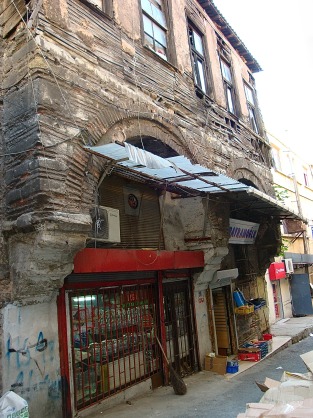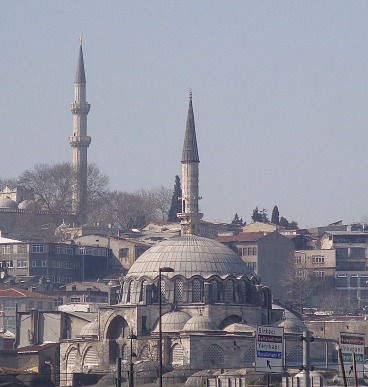“Wooden Castle”

Across the concrete square beside the Mısır Carşısı (Spice/Egyptian Bazaar) in Eminönü, Tahtakale is the delightfully ramshackle area immediately to the south of the Galata Bridge. It’s a world of jampacked narrow streets filled with tiny shops selling everything from colourful packaging to freshly roasted coffee beans with not an international brand-name in sight. A true oriental bazaar, in other words, and something of an antidote to the more touristy offers of both Mısr Çarşısı and the Kapalı Çarşi (Grand Bazaar).
The great thing about Tahtakale is the way in which a variety of early Ottoman monuments, including mosques and ancient hans, are seamlessly woven into the fabric of the neighbourhood. With the exception of the much-loved Rüstem Paşa Cami on its lofty perch, most of these monuments go virtually unnoticed by the shoppers thronging the streets.
Rüstem Paşa Cami
The Rüstem Paşa Cami is actually easier to spot from a distance than when you are close to it. This is because its dome and single minaret are given greater prominence on the skyline by the fact that they were built on a stone platform – precisely the reason why, when you’re standing right beside it, you might fail to notice it. Look out for steps leading up inside the platform which will bring you out in front of its beautifully tiled exterior. The shops housed in the ground floor of the platform were an arasta, proving funds for the maintenance of the mosque.
The mosque was commissioned from Sinan in 1561 by Mihrimah, wife of the grand vizier Rüstem Paşa who had recently died. As is often commented, the Rüstem Paşa Cami is more obviously blue than the famous “Blue” Mosque, with both its exterior and interior covered in fine İznik tiles. However, it is also noteworthy for the quantity of “Armenian bole“, a deep red, slightly protuberant glaze that was liberally used to create beautiful designs of carnations and tulips.
 It’s not immediately obvious but two old hans still survive from the mosque complex. The Büyük Çukur Hanı (Big Sunken Han) and Küçük Çukur Hanı (Small Sunken Han) are easier to spot if you are approaching Tahtakale from the water-facing side rather than from across Eminönü Meydanı (square). Once you’ve spotted them you will more readily find the winding alley that leads round to the entrance to the mosque. It’s a strange and picturesque corner of the city where hamals (porters) still wait to carry loads on their back and huge sacks of herbs and spices scent the air.
It’s not immediately obvious but two old hans still survive from the mosque complex. The Büyük Çukur Hanı (Big Sunken Han) and Küçük Çukur Hanı (Small Sunken Han) are easier to spot if you are approaching Tahtakale from the water-facing side rather than from across Eminönü Meydanı (square). Once you’ve spotted them you will more readily find the winding alley that leads round to the entrance to the mosque. It’s a strange and picturesque corner of the city where hamals (porters) still wait to carry loads on their back and huge sacks of herbs and spices scent the air.
You may not be able to get access to the Büyük Çukur Hanı but if you do you will be able to see very faded frescoes just about surviving inside one of the domes at the end of the upper gallery which is home to many small workshops.
The Küçük Çukur Hanı is more readily accessible as most of its upper level serves as a repository for second-hand clothing. Right beside it on the waterfront but never part of the mosque complex is the restored 16th-century Kiraz Hanı (Cherry Han), once used for storing wine and possibly built right into the Sea Walls (these finally vanished from Eminönü in 1980 as part of road-widening work).
Around Tahtakale
Tahtakale harbours several other old hans which you will probably find more by luck than judgement. The most obvious is the battered 16th-century Kızıl (Papaz) Hanı (Red (Priest’s) Han), its twin names reflecting its redbrick-and-stone facade and the fact that it was paid for by a priest’s son. Today it looks straight across Eminönü Meydanı to the Golden Horn and is fronted by a tiny branch of the Kahve Dünyası cafe chain.
Immediately facing it in the narrow streets of Tahtakale is the Hurmalı Hanı (Date Han) which may have been used to store a fruit which is still very important in Islam, not least because it is believed that the Prophet Mohammed used dates to break his daily fast during Ramadan.
Nearby is the Balkapakanı Hanı where honey may once have been stored. Its architecture suggests that some parts of it may date right back to the fifth century although it has been much patched up over the centuries.
Both these hans are close to the Rüstem Paşa Cami as is the lovely Tahtakale Hamamı which does not seem to have been part of the complex despite being so close to it; there is no certainty about its age although it probably belongs to the 15th century. Today it houses small shops and an inviting cafe done up in orientalist style.  Saman Emin-i Evvel Cami (Samanveren Cami)
Saman Emin-i Evvel Cami (Samanveren Cami)
Also worth a quick look is the 15th-century Saman Emin-i Evvel Cami (Samanveren Cami) whose minaret, with windows just below the cap, is particularly unusual. It has a virtual twin in the nearby Timurtaş Cami (Hallaç Abdurrahman Sokak) as you walk towards Küçükpazarı.
Drinking
Long before drinking decent coffee became a ho-hum activity in the city, there was always one corner of the city where you were guaranteed to smell the alluring aroma of roasting coffee beans and that was on Tahmis Sokak where the Mısır Çarşisi empties into Tahtakale. Here stood – and still stands – Kurukahveci Mehmet Efendi, a coffee shop which has been in business since 1871 within walking distance of the city’s very first coffee shop which is believed to have opened near Rüstem Paşa Cami in 1554.

Now you can not only buy packets of freshly roasted coffee to take away but also sample it in a small courtyard cafe, then go indoors to inspect a library full of books on the topic of coffee and a small museum that tells the story of how the business weathered family and political ups and downs over the last 150 years. The building itself – often overlooked in the crush of people here – is a magnificent piece of Art Deco designed by Zühtü Başar in 1932. .
Transport info
Tahtakale is readily accessible by tram to Eminönü and then a short walk across the square. It’s also just minutes’ away from Küçükpazarı bus station where buses from all over the European side of the city terminate near the Haliç Metro station.
Nearby areas


